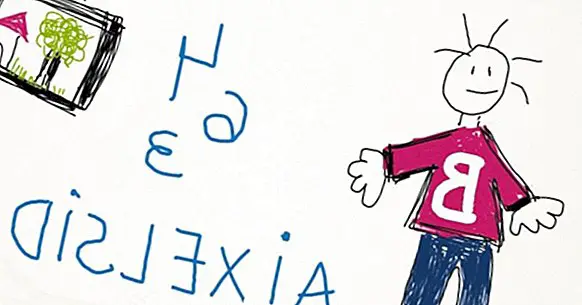Dyslexia: causes and symptoms of reading difficulties
For many people reading is a hobby, a pleasant hobby that induces us to relax and imagine stories and worlds different from ours or to reflect on the different areas of life. It is also a way of learning and acquiring knowledge, capturing and endowing its meaning with the written symbols we perceive through the vision, the graphemes.
But reading fluently is not something that is easily achieved . It takes a long process of learning and automation so that reading can become a way of acquiring information. And not in all cases this process is given in a normative manner.
In some people reading is a tremendously complicated process, making frequent mistakes that make it difficult to understand what is written. Many of these cases of people with reading difficulties suffer from a reading learning disorder that in turn can affect academic and work performance: dyslexia .
Dyslexia: a learning disorder
People suffering from dyslexia or learning disorders with reading difficulties present a learning pattern with severe difficulties in recognizing words at the written level. In addition to it these individuals they usually show little spelling and spelling ability , being frequent that also they have some difficulties in the mathematical reasoning (dyscalculia).
The main problem of the subjects with dyslexia is in the precision with which they confront the fact of reading, causing the little precision in the reading of words. This lack of precision causes frequent errors commission , the most common being the presence of omissions of letters and sounds, repetitions and hesitations during reading, translations of the position of letters within a word, insertion of new sounds, substitutions in sounds or words or use of more frequent derivatives of is.
In addition, dyslexia rarely appears alone; it produces many other learning problems related especially to reading comprehension. The fact of that there is a very low reading speed difficult to understand the material read.
Since it is a problem that occurs at an early stage of development, the effects of dyslexia can cause a bad adjustment in the academic and labor environment . It can also cause serious problems of self-esteem that can extend throughout life. Frequently, the fact of not being able to read correctly causes people with dyslexia to actively avoid reading, especially if reading becomes aversive due to insistence in which they read correctly.
Diagnosis
Dyslexia is a disorder of chronic neurodevelopment, being the most frequent learning disorder . Although the errors that are committed in the reading are normal at certain ages, to be diagnosed of this disorder it is necessary that the reading skills are well below what is expected in an individual of the same maturational level and level of intelligence. It has neurological causes of genetic basis and needs to be treated in order to improve the performance and adaptability of the sufferer.
Theory of the double route
The existence of this disorder and the fact that the ability to read is an important part of our daily life have been explored and investigated from different theories. One of the most accepted is that of the Morton model, with its theory of the double way of the processing of the reading information .
The first way to which the author refers is the direct or lexical route through which a global reading is made , recognizing the words as a whole without needing to visualize the complete word. In this way, visual stimulation is basically used to obtain information.
The second way that this theory proposes, the phonological path, would work indirectly to need to relate the visual stimulus with the sounds it represents and then these sounds with their meaning. This second process requires that the information be converted from grapheme to phoneme, so that the process is somewhat longer. It is used fundamentally when we do not know the word to read, being new for us and not having previous references of it.
In dyslexia one or both of the ways seem not to work correctly , causing the typical errors of this disorder. To better understand what happens during this disorder, we first see the typical development process of the ability to read.
The typical development of the ability to read
As we have said, the ability to read is acquired through a prolonged learning process, and in turn affects the rest of the development as the fundamental reading results in order to follow the formative process typical of formal education.
In a first phase called logographic the child will use the basic form of the word to recognize elements that are familiar , without taking into account (and even without knowing) the sounds that each letter represents.
Later, Around the age of five the children begin to be aware that the letters represent specific sounds and that they mean something, appearing the ability to mentally convert sounds into visual symbols and letters into sounds. This phase is known as alphabetic, and in them the children already begin to syllabicate and separate the phonemes.
Finally, approximately around seven or eight years would reach the spelling phase , in which the individual would be able to analyze words from their syntax at a level that with time and practice will end up being equal to that of an adult.
However, people suffering from dyslexia for some reason have problems somewhere in this process, not being able to fully recognize the form of the word, transform it into sound or both.
Types of dyslexia
Dyslexia in a relatively frequent learning disorder, but the type of mistakes made can vary greatly depending on the type of path to reading that is damaged. We can find several types of dyslexia and different ways to classify them but being the model of the double route of access to reading one of the most accepted the most commonly used typologies are the following.
1. Phonological dyslexia
In this type of dyslexia, people present a damage in the phonological pathway, being able to access the reading only through the visual route. In this way, the reader is unable to correctly associate the written word with its pronounced equivalent, reading only from the visual form of the word.
This is why in this type of dyslexia many mistakes are often made when reading pseudowords (Invented words), since they tend to associate words of which they know the form with others. They often make declensions of the word and frequently fail in words with function (for example, prepositions).
2. Surface dyslexia
In superficial dyslexia the problem of reading is essentially in the reading of irregular words. The path to damaged reading would be lexical, having to focus on the sounds and phonemes of the word in order to read.
In this case, those who suffer from this type of dyslexia they have trouble reading the words globally , having difficulties when it comes to associating letter and sound. They often make mistakes in words that sound the same, and a high level of slowness in reading and hesitation is common, making several attempts to find the right word.
3. Deep dyslexia
Deep dyslexia can be understood by considering that both the phonological path and part of the lexicon do not work correctly. The person reads through the visual, but as this route is also damaged, the problems are much greater, being able to suffer errors of semantic type next to others own of the other two types of dyslexia .
Treatment and educational recommendations
Dyslexia is a problem that affects a large number of people, and detecting and managing it correctly can be fundamental in order to facilitate the normative development of the individual and its adjustment in society.
After the diagnosis, which is carried out using procedures and batteries standardized and popular evaluation such as TALE or PROLEC In schools and teams of counseling and psychopedagogical attention, the start of treatment should be initiated as quickly as possible in order to avoid complications and facilitate development.
The treatment to be carried out will depend on the patient's abilities, having to adapt the strategy to be applied according to the possibilities of each case . At first, the most problematic areas will have to be identified, in order to work on them little by little and, as improvements are made, to introduce more complicated elements.
Training in literacy and motivation
A fundamental part of the treatment is to do a literacy training, increasing the level of phonological awareness of the subject little by little at the same time that in a patterned way the time spent reading aloud (and to be able to be from attractive and adapted texts for individuals with dyslexia) is gradually increasing.
It is also very useful use multisensory methods that allow to relate the information coming from the different senses , strengthening the ability to link vision and hearing.
It is essential that the treatment contain elements that help motivate the child (or adult, if it has not been diagnosed before) and increase their confidence, being essential the collaboration of family members and teachers so that reading does not become torture. It is recommended to read them at home so that they see reading as something enjoyable and positive. It should be avoided as far as possible criticize its performance , because it is frequent that due to this they end up becoming insecure and avoiding reading.
Bibliographic references:
- American Psychiatric Association. (2013).Diagnostic and Statistical Manual of Mental Disorders. Fifth edition. DSM-V. Masson, Barcelona.
- Frith, U. (1999). Paradoxes in the definition of dyslexia. Dyslexia, 5, 192-214.
- Roca, E .; Carmona, J .; Boix, C .; Colomé, R .; López, A .; Sanguinetti, A .; Caro, M .; Sans, A. (Coord.). (2010). Learning in childhood and adolescence: keys to avoid school failure. Esplugues de Llobregat: Hospital Sant Joan de Deu.



















